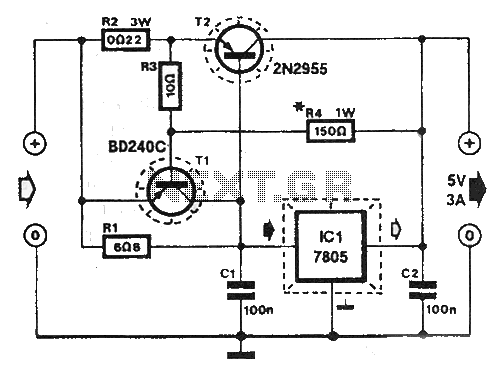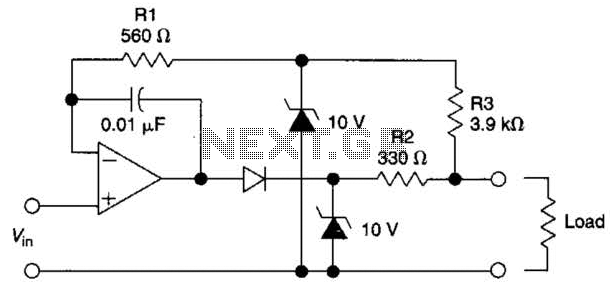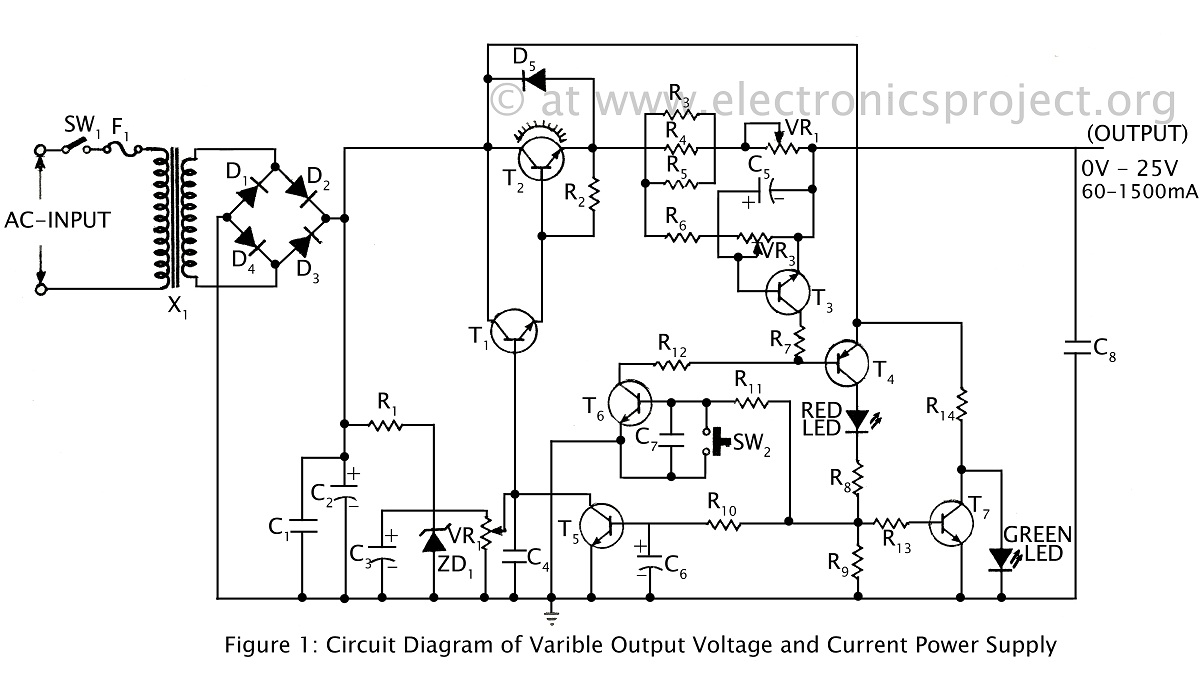
protected

A voltage regulator is designed to provide a fixed voltage to any load. This inherently means it must supply the necessary current through that load to satisfy Ohm's Law, I = V/R. As the resistance (R) approaches zero, such as when the output is shorted to ground, a fixed voltage (V) results in current (I) approaching infinity. Consequently, the regulator output will, without an imposed current limit, attempt to deliver infinite current. This situation can lead to the output device vaporizing its internal wiring or fusing into a short circuit, potentially damaging other components. It is important to clarify that this circuit was previously referred to as a foldback limit, which is misleading. A true foldback circuit not only limits current during a short circuit but also reduces its value. The small resistor in the emitter circuit of the output device is utilized to sense the current flowing to the load; when the current reaches a certain threshold, the voltage across this resistor activates the limit transistor. This limit transistor then diverts drive current from the output device, effectively limiting the output current. A fundamental limitation to minimum output impedance is presented by the sense resistor used in the current limiter, which typically ranges from 0.1 to 1 Ohm. Belleson has developed an innovative solution to this issue that does not require a sense resistor in the emitter circuit. Instead, it senses a voltage difference internal to the regulator, allowing the emitter to connect directly to the load. While a schematic illustrating this clever innovation cannot be provided due to proprietary constraints, it can be asserted that the speed, dynamics, stability, low noise, and low output impedance performance of Superpower remain uncompromised until the protection circuit begins to limit the current. However, there is a minor compromise: the drop-out voltage of the SPL increases to approximately 4V at 2A, compared to 1V at 2A for the unprotected SPJ. Monolithic regulators typically incorporate both a short circuit current limiter and a thermal limiter. In contrast, Superpower does not include a thermal limiter, meaning that under short circuit conditions, the output device must be adequately heat-sinked to dissipate power calculated as Vin multiplied by Isc without overheating.
Voltage regulators are crucial components in electronic circuits, ensuring that a stable output voltage is maintained regardless of variations in input voltage or load conditions. The operation of a voltage regulator is fundamentally based on controlling the output current to prevent excessive flow that could damage the circuit. The implementation of a current limiting mechanism is essential, particularly in scenarios where a short circuit may occur.
The use of a sense resistor in the emitter circuit serves a dual purpose: it allows for the measurement of the load current while also introducing a minimum output impedance. However, this can be a limiting factor in the performance of the regulator. The innovative approach adopted by Belleson eliminates the need for a sense resistor, which enhances the overall efficiency and output characteristics of the regulator. By sensing voltage internally, the design minimizes the impact on output impedance and allows for more direct connection to the load, thus improving performance metrics such as speed and stability.
Thermal management is another critical aspect of voltage regulator design. The absence of a thermal limiter in the Superpower design necessitates careful consideration of the heat dissipation requirements. Under short circuit conditions, the output device must be capable of handling the power dissipation without exceeding temperature limits, which is contingent upon proper heat sinking. The design of the heat sink must account for the maximum input voltage and the short circuit current to ensure reliable operation and longevity of the device.
In summary, the voltage regulator's design intricacies, including current limiting and thermal management, are vital to its performance and reliability in electronic applications. The advancements made by Belleson in eliminating the sense resistor while maintaining performance integrity illustrate the ongoing innovation within the field of voltage regulation.A voltage regulator is designed to provide a fixed voltage to any load. Inherently this means it must provide any current through that load to satisfy Ohm`s Law of I = V/R. As R approaches zero, for example when the output is shorted to ground, for a fixed V then I approaches infinity. Thus the regulator output will, without some imposed current l imit, attempt to provide infinite current. Physics takes over and typically the output device vaporizes its internal wiring or fuses the device into a short circuit and some other component burns. Note: this circuit was previously called a foldback limit but in fact is not one. A foldback circuit not only limits current in a short circuit but also reduces its value. Sorry for any confusion! The small resistor in the emitter circuit of the output device is used to sense the current flowing to the load and, when current is high enough the voltage across it turns on the limit transistor.
This limit transistor then steals drive current from the output device, which limits output current. You can see a fundamental limitation to minimum output impedance is the sense resistor used in the current limiter. The impedance can be no lower than the sense resistor, which is typically between 0. 1 and 1 Ohm Belleson has developed an ingenious solution to this problem which does not require a sense resistor in the emitter circuit.
It instead senses a voltage difference internal to the regulator, thus allowing the emitter to connect directly to the load. It would be great if we could illustrate with a schematic this clever innovation but it is, unfortunately, proprietary information.
Yet we can definitely say the speed, dynamics, stability, low noise and low output impedance performance of Superpower are not compromised at all until the protection circuit begins to limit the current. OK, you`re right. There is a compromise, yet it`s a small one and it`s not at the output. The SPL drop-out voltage increases to about 4V at 2A vs. 1V at 2A for the unprotected SPJ. Monolithic regulators have, in addition to a short circuit current limiter, a thermal limiter. Superpower does not have a thermal limiter. This means under short circuit conditions the output device must be heat sinked adequately to dissipate power of Vin * Isc without overheating the output device.
🔗 External reference
Voltage regulators are crucial components in electronic circuits, ensuring that a stable output voltage is maintained regardless of variations in input voltage or load conditions. The operation of a voltage regulator is fundamentally based on controlling the output current to prevent excessive flow that could damage the circuit. The implementation of a current limiting mechanism is essential, particularly in scenarios where a short circuit may occur.
The use of a sense resistor in the emitter circuit serves a dual purpose: it allows for the measurement of the load current while also introducing a minimum output impedance. However, this can be a limiting factor in the performance of the regulator. The innovative approach adopted by Belleson eliminates the need for a sense resistor, which enhances the overall efficiency and output characteristics of the regulator. By sensing voltage internally, the design minimizes the impact on output impedance and allows for more direct connection to the load, thus improving performance metrics such as speed and stability.
Thermal management is another critical aspect of voltage regulator design. The absence of a thermal limiter in the Superpower design necessitates careful consideration of the heat dissipation requirements. Under short circuit conditions, the output device must be capable of handling the power dissipation without exceeding temperature limits, which is contingent upon proper heat sinking. The design of the heat sink must account for the maximum input voltage and the short circuit current to ensure reliable operation and longevity of the device.
In summary, the voltage regulator's design intricacies, including current limiting and thermal management, are vital to its performance and reliability in electronic applications. The advancements made by Belleson in eliminating the sense resistor while maintaining performance integrity illustrate the ongoing innovation within the field of voltage regulation.A voltage regulator is designed to provide a fixed voltage to any load. Inherently this means it must provide any current through that load to satisfy Ohm`s Law of I = V/R. As R approaches zero, for example when the output is shorted to ground, for a fixed V then I approaches infinity. Thus the regulator output will, without some imposed current l imit, attempt to provide infinite current. Physics takes over and typically the output device vaporizes its internal wiring or fuses the device into a short circuit and some other component burns. Note: this circuit was previously called a foldback limit but in fact is not one. A foldback circuit not only limits current in a short circuit but also reduces its value. Sorry for any confusion! The small resistor in the emitter circuit of the output device is used to sense the current flowing to the load and, when current is high enough the voltage across it turns on the limit transistor.
This limit transistor then steals drive current from the output device, which limits output current. You can see a fundamental limitation to minimum output impedance is the sense resistor used in the current limiter. The impedance can be no lower than the sense resistor, which is typically between 0. 1 and 1 Ohm Belleson has developed an ingenious solution to this problem which does not require a sense resistor in the emitter circuit.
It instead senses a voltage difference internal to the regulator, thus allowing the emitter to connect directly to the load. It would be great if we could illustrate with a schematic this clever innovation but it is, unfortunately, proprietary information.
Yet we can definitely say the speed, dynamics, stability, low noise and low output impedance performance of Superpower are not compromised at all until the protection circuit begins to limit the current. OK, you`re right. There is a compromise, yet it`s a small one and it`s not at the output. The SPL drop-out voltage increases to about 4V at 2A vs. 1V at 2A for the unprotected SPJ. Monolithic regulators have, in addition to a short circuit current limiter, a thermal limiter. Superpower does not have a thermal limiter. This means under short circuit conditions the output device must be heat sinked adequately to dissipate power of Vin * Isc without overheating the output device.
🔗 External reference


